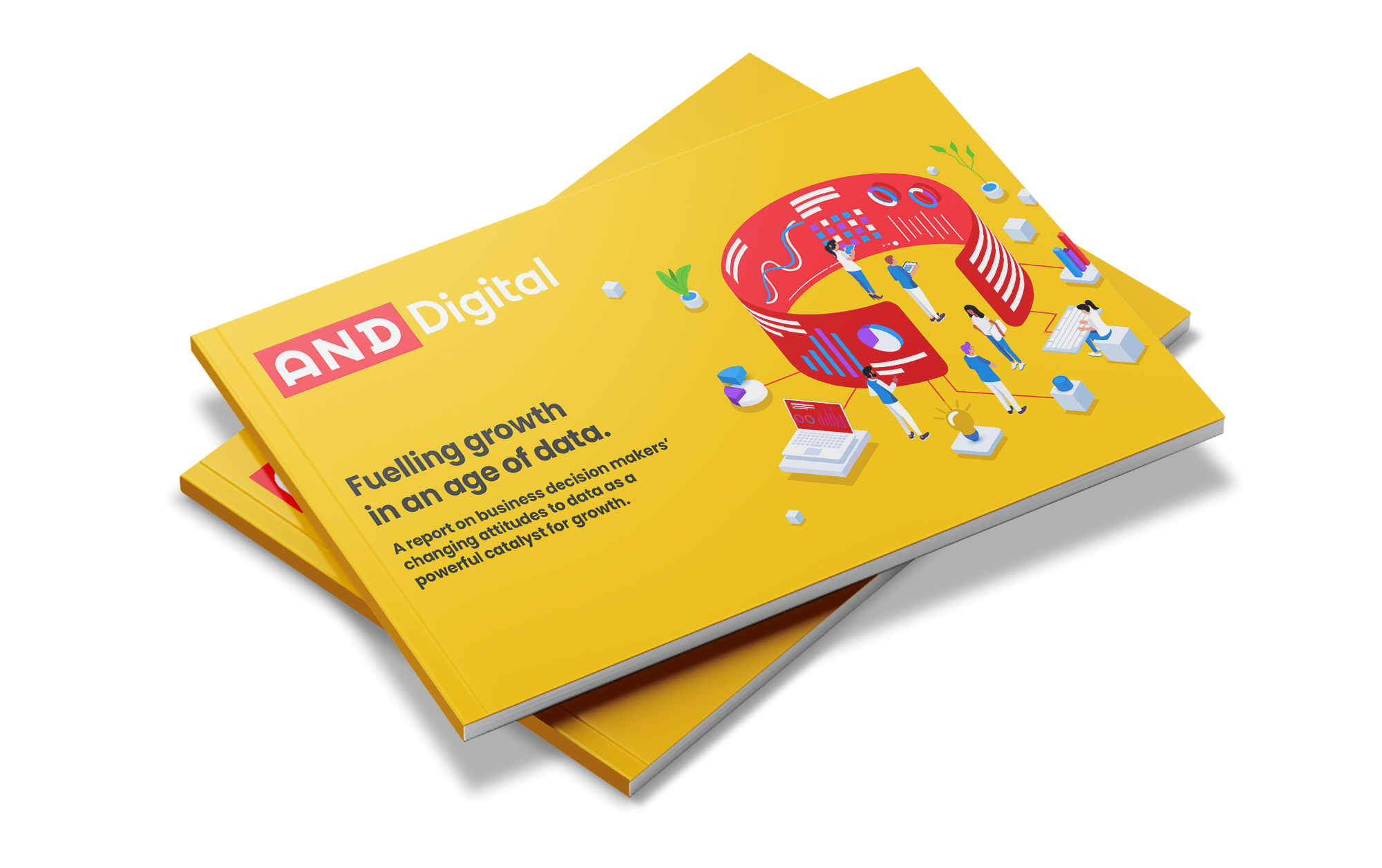Your business may have accumulated a lot of data over the years, but do you know how to channel this insight into an effective data strategy?
Ok, you’re data driven: But what does it really mean?
The importance of data cannot be argued.
In the modern-day, It’s often the catalyst behind a business’s decision making.
his is because data can provide valuable insights into a businesses history, help to identify trends, give a better understanding of consumer behaviour and even predict the future.
And it’s often all-encompassing, in the sense that learnings from data collected on the website are transferable to offline business practices and vice versa, providing a visualisation of a ‘bigger picture’ if you will.
Ultimately it presents a business with vast opportunities to learn what’s working and what isn’t quickly, so that their offering can be adapted to effectively appeal to their target audience.
But whilst the benefits of data are vast, many businesses are often overwhelmed by the sheer abundance of figures that they’re presented with.
So with that being said, this blog post looks to review the state of data, how it can be used to deliver outcomes and what is meant by being truly data driven.
The state of data
The pace of digital development accelerated exponentially during the pandemic.
Even in the post pandemic world, it appears that business leaders are still focussed on harnessing and utilising data to drive company growth.
In a study by AND Digital, ‘Fuelling Growth in an Age of Data’, 72% of business decision makers agreed that their ability to collect, analyse and make meaningful decisions with data is of increasing importance.
However, 22% of those surveyed were worried that they would not have the ability to collect, process and analyse that data in a way that would complement their strategy to promote growth and support their wider business operations.
So what is it that’s holding businesses back?

Image Source: AND Digital
Data Anxieties
There are a number of factors that are influencing a businesses adoption of a data-driven model.
Whether it’s cost, time to implement new technology, concerns on data security or simply lack of staff knowledge and skill set; there are many roadblocks to be overcome.
The crux is that the desire is there, but it can be a monumental task that would put the frighteners on any department.
Regardless, it has never been more important for businesses to not miss out on the opportunities and insight that their business data provides, applying the learnings effectively and intelligently to promote growth.
So where do we start? Turning data into outcomes
First and foremost, with any business strategy, it’s important to understand your business’s aims, objectives and what your desired outcome looks like.
Whether that’s improving the efficiency of the business, identifying new market opportunities, improving revenue, or making improvements to your digital portfolio, like your company website or app.
Once you have a goal in mind, you can look at what data you have, or alternatively, what data you can collect going forwards, to provide the basis for your analysis.
How to use data effectively
We always highly advise that you have an analytics service in place on your website, such as Google Analytics 4 (GA4).
User data will be tracked from your website and funnelled into the analytics platform, giving you access to user-centric data.
Whilst the interface can be a little intimidating at times the information that you will have readily available at your fingertips is of great value.

Data can help you determine where your traffic comes from.
Your website data will show where and how people find you, whether via a social media post, paid ad, or search engine.
And once you determine which pathways into your website aren’t performing as well as they can be, you can direct time and resources to improve the visibility at the source of these access points via ongoing website optimisation.
Identify weak points
If you have ‘sales funnel’ data, this can give you insight as to which point of the process users get to before ‘bouncing’ or clicking away from the page.
If you notice that the majority of the users are exiting consistently at a certain stage of the process, you can accurately diagnose the location of a potential issue and identify how to fix it.
It may be as simple as a broken link, the page content being too confusing, or elements within the process not being user-friendly.
Ultimately, the data collected will help your business make a conscious decision as to whether elements need to be adjusted to encourage conversion and improve revenue.
Ensure compatibility
Your data will provide insight into how customers are viewing your website.
If the majority of your users are visiting the site via their mobile device, your website needs to be fully responsive to ensure the mobile-experience is up to scratch.
Browsers such as Edge, Firefox and Chrome will render certain digital elements differently, so making sure you’re ensuring cross-compatibility for different browsers is also key.
It’s the reason why we look at the latest browsers, mobile OS’ and devices when we’re building our websites, to ensure there’s a consistent experience across each.

Bestsellers and bad sellers
Sales data will give your business an insight into your top performing products or services.
Whether you’re using Hubspot, WooCommerce , or payment gateway data from Paypal or Stripe.
By knowing what is doing well and what is doing…not so well, you can make a business decision to eliminate potential products or services that aren’t profitable, giving you more time to focus on those that are.
And the survey says…
Surveys are a great way for your business to collect data from your customers.
They can provide business with valuable, unabashed views from a group of individuals on a specific product or service, or more generally can give customers a voice about what they like, or don’t like about your organisation.
In whichever iteration, the data collected from these surveys can be compared and scrutinised to see if there are any trends or correlations between the feedback.
For example, if the majority of those surveyed are more receptive to a certain social media platform, you can align your marketing efforts to reflect this.
Alternatively, if many customers are unimpressed with your aftercare or found they needed more support with a product than what was available to them, you could add an FAQs section or guide onto your website to address this need.

A/B and Multivariate Testing
A/B and multivariate testing allows businesses to remove the guesswork when it comes to optimising different marketing mediums and offerings.
In its simplest iteration, A/B testing will allow marketers to glean what metrics perform better in an experiment of two variants of differing formats.
From the results, businesses will have a better understanding of what formatting, or piece of content, is the most successful and engaging. The measurement of which could be an increase in click-throughs or conversions.
Essentially, multivariate testing offers the benefits of A/B testing, along with more granular data concerning multiple elements on the page, be it font size, CTA button colour differentiations.
Once again, it’s about understanding what stylistic or layout changes your users are more susceptible to.
From this data, your business can really hone your marketing with visuals and a user-experience that has been proven to convert.
It really does take any conjectures out of the decision making, giving you the precision to hone your offering to perform as optimally as you can.
Predict customer behaviour
You don’t need a sixth sense to predict how your customers interact with your business, you just need good data.
Interpreting data to understand how users behave can help your business to create user-profiles, which can then be attributed to specific channels e.g. your website, or social media profiles.
This could be as simple as anticipating which products and services certain customer groups might need.
Similar to how Amazon makes suggestions on what you’d might also like to purchase, based on your recent searches and orders.
And we’re not saying you have to delve into this as intricately as Amazon does, as there are many ways to provide a similar feature without the need for an Amazon budget!
You could include adequate signposting on a product page on your website, targeting customers who have purchased, with remarketing on social platforms or email.
Ultimately as with many of the insights above, any data collected offers fluidity to be applied to your business practises as a whole and not segmented to just a small part
So how do you become truly data-driven?
A data-driven business very simply is one that has embraced the use of digital-technology to address and solve problems with data.
But the data is nothing without purpose.
As such it’s important that your first steps in utilising the power of data for your business, is to identify what your business needs and how to achieve your objectives.
It’s also equally important to understand what data you’re collecting, and where from, as different platforms will offer varying levels of analytic capabilities.
So that it’s not too much all at once, take time to focus on one platform, understand the data it collects and how it can be applied to your business.
From here you can understand what data tools are available to collate quality data to align with your goals and advance your business to the next level.
